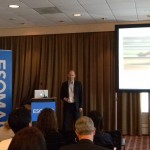Elissa Moses of EmSense and Paul Jansen of Foot Locker Europe discussed how the biggest sports retailer in the world went about seducing the customer – i.e. getting them to buy…
The great thing about this presentation was that it featured a client sharing a real life experience. This is important for taking Neuroscience to the next level and making people understand it. … real shoppers, real stores, real experience.
Often people think, “It’s not why did you buy … but why didn’t you buy it that matters.” In fact, Jensen notes that this is the wrong way to look at it. Why? Because, people don’t really know why they do or don’t buy because they give rationalised answers.

EmSense began by exploring how customers feel from the moment they approach the store outside to the point of purchase. Looking at EEG results, Foot Locker and EmSense observed people to see what drove conversion. They broke the shopping experience into key elements and looked at shopper response profile as a journey. Going from scanning phase (looking at aisle), evaluation phase (should I try on our not), select (including shopper engagement with sales staff) and purchase or rejection.
During the scanning period – they found that this stage is a lot of work. Cognition is high … there is a negative emotion while browsing, until a product is selected for evaluation. At the point of decision, emotion overtakes cognition. They also found that mirrors can provide a really satisfying experience and Foot Locker actually added more to their stores after this.
Another revealing insight dealt with interaction with sales people – which taught Foot Locker a lot about what their sales teams do well and shouldn’t do. Overall, the staff was highly influential on conversion – i.e. people like positive interaction – “that looks good”. However, when sales staff interrupt, even if to offer help, it causes distractions and can often lead to losing the sale.
Foot Locker and EmSense then explored the law of appropriation – i.e. seduction of the customer. Jansen gave example of asking people if they want to buy a cup. If they handled the cup they had more inclination to purchase it.
They repositioned stores to reflect this and the results from this research proved successful with a large increase in conversion and profit and the number of customers who stated “I will definitely come back” increasing from 48% to 63%.
Phil Barden then talked about the relaunch of the T-mobile brand. The implicit system is driven by rewards. Quoting Omar Mahmoud from the

morning – the brain tells the eyes what to see – Phil Barden, of Decode Marketing, discussed how they helped T-mobile by using psychometric measurement of association between two objects to get them stronger market share and connect better with their customers and branding.
People choose and use brands that help them to achieve their goals and the testing used was user-friendly, cost-effective and global with online access panels. It measured what fires together in the brain – is wired together in the brain – and creates associations.
How does the brain respond to a strong brand?
FMRI results show that the brain on the right is the one that responds to favourite brand. Brain on the left is thinking and on the right it is in autopilot mode. Weak brands make people process while strong brands require less effort from the consumer.
Decode explored how strongly is the reward associated with the brand. – i.e. quality, strength and then got baseline measure of implicit view of the brand. Looking at purchase intent, likelihood to stay and Net Promoter Score, Decode found 4 or 5 rewards which were drivers of satisfaction. They then used this to help T-Mobile create new brand propositions, communications platform and a new look and feel.
This worked brilliantly on an external level with the creation of a flashmob advertisement, which subsequently increased sales by 49%, increased market share by 6% and generated 29 million YouTube views. Internally, the T-Mobile has now integrated this approach for brand success throughout the company.
Greatest success a brand can have is to be chosen without thought…implicit…it’s a no-brainer.
Next came , Ruihong Tang, over from China to share study results on applying eye tracking and EEG to online video advertising in the Chinese market. China has 457 million internet users and 240 million are online video users and 23.7% don’t watch TV.
The problem with the online industry in China is the difficulty in determining who has looked at your ad and whether they liked it. The questions of “how much” and “which media to invest in” are leading discussions.
They used popular online Chinese media portals such as youku.com to – more expansive than YouTube – a bit like TV on demand online to try and explain how do you know your ad is exposed to a client. Location of the advertisement, timing, exposure is increasingly important.
Using eyetracking, they were able to truly calculate where eyes go with an online ad, what is the best real estate for an ad and looked at how long people fixate on the ads. Not surprisingly, fixation rates for online ads/videos are quite short, but certain places generated which formats, sizes and locations in a web layout were best for catching the web users attention and memory towards advertising products. But most importantly, they found that companies must engage their customers in the right place, at the right time, in the right way and with the right message.


